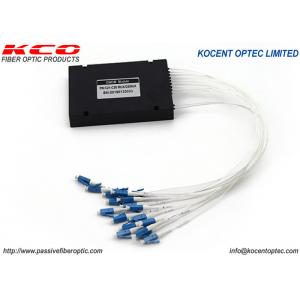

Add to Cart
200G 75GHz 16CH Channel Passive Fiber Optic DWDM ABS Module Box LC/UPC Connector
Descriptions:
- Coarse WDM (CWDM): CWDM is defined by WDM systems with fewer than
eight active wavelengths per fiber. CWDM is used for short-range
communications, so it employs wide-range frequencies with
wavelengths that are spread far apart. Standardized channel spacing
permits room for wavelength drift as lasers heat up and cool down
during operation. CWDM is a compact and cost-effective option when
spectral efficiency is not an important requirement.
- Dense WDM (DWDM): DWDM is defined in terms of frequencies. DWDM’s
tighter wavelength spacing fits more channels onto a single fiber,
but costs more to implement and operate. DWDM is for systems with
more than eight active wavelengths per fiber. DWDM dices spectrum
finely, fitting 40-plus channels into the C-band frequency range.
- Dense wavelength-division multiplexing (DWDM) is an optical fiber multiplexing technology that is used to increase the bandwidth of existing fiber networks. It combines data signals from different sources over a single pair of optical fiber, while maintaining complete separation of the data streams.
- A separate light wavelength carries each signal, and the dense in DWDM refers to its ability to accommodate up to 80 different wavelengths. Each wavelength is about 0.8 nanometer wide and shares a single optical fiber.
- Fiber optic cables now commonly form the backbone of carriers' interoffice networks, representing the standard for the telecommunications infrastructure. DWDM enables enormous amounts of data to traverse a single network link by creating multiple virtual fibers, significantly multiplying the capacity of the physical medium.
- As data flows through distinct wavelengths, the streams or channels do not interfere with each other. This approach helps maintain data integrity. As a result, this enables security-related partitioning or separate tenants in the same data center.
Because of its ability to handle so much data, DWDM is popular with telecommunications and cable companies. It is an integral part of their core networks.
- DWDM is also highly suitable for anyone running densely populated data centers, such as hyperscale cloud service providers operating infrastructure as a service or colocation providers with dense multi-tenant spaces.
- DWDM is a predecessor to a similar technology: time-division multiplexing (TDM), which telecommunications operators use to routinely transmit information at 2.4 gigabits per second (Gbps) on a single fiber. Some also deploy equipment that quadruples that rate to 10 Gbps. However, demand for high-bandwidth applications created capacity demands that exceeded traditional TDM limits.
Applications
- DWDM System
- CATV networks
- Metro
- PON Systems
- FTTx Systems
- Data Central
Key Features
- Low Insertion Loss
- Wide Wavelength Range
- High Channel Isolation
- High stability and reliability
- Epoxy-free optical path
- Wide Operating Wavelength: ITU DWDM C&L Band
Product advantage:
- One of the biggest advantages of DWDM is the use of optical amplifiers, which can amplify the entire DWDM spectrum and overcome long spans of attenuation and fiber loss, enabling cost-effective transmission over long distance.
- The optical amplifiers are managed and configured as part of the optical network and have adjustable gain and operation modes.
- The optical multiplexer/demultiplexer (mux/demux) supports 4 to 96 DWDM channels in the fiber, with 50GHz, 75GHz and 100GHz spacing, according to the output standards.
Product photo:
| DWDM C-band λc Wavelength Guide | |||||
| ITU Channel Code | Wavelength | ITU ChannelCode | Wavelength | ||
| 21 | 1560.61 | 41 | 1544.53 | ||
| 22 | 1559.79 | 42 | 1543.73 | ||
| 23 | 1558.98 | 43 | 1542.94 | ||
| 24 | 1558.17 | 44 | 1542.14 | ||
| 25 | 1557.36 | 45 | 1541.35 | ||
| 26 | 1556.55 | 46 | 1540.56 | ||
| 27 | 1555.75 | 47 | 1539.77 | ||
| 28 | 1554.94 | 48 | 1538.98 | ||
| 29 | 1554.13 | 49 | 1538.19 | ||
| 30 | 1553.33 | 50 | 1537.4 | ||
| 31 | 1552.52 | 51 | 1536.61 | ||
| 32 | 1551.72 | 52 | 1535.82 | ||
| 33 | 1550.92 | 53 | 1535.04 | ||
| 34 | 1550.12 | 54 | 1534.25 | ||
| 35 | 1549.32 | 55 | 1533.47 | ||
| 36 | 1548.51 | 56 | 1532.68 | ||
| 37 | 1547.72 | 57 | 1531.9 | ||
| 38 | 1546.92 | 58 | 1531.12 | ||
| 39 | 1546.12 | 59 | 1530.33 | ||
| 40 | 1545.32 | 60 | 1529.55 | ||
Relation products:
OEM/ODM Service:
- If you want to show your own brand LOGO on the goods such as
cable, package bag, label or any where. Our OEM and ODM service is
always ready to do it. Please contact with our sales team to get
best support.
Packing:
- According to Stardard Export Packing.
- Carton box, wooden box, wooden pallet.
Shipping:
- International express such as UPS, TNT, DHL, etc
- Internatioal air: CA, AA, EA, etc
- By sea
- Standard export sea port: Shenzhen, Hongkong, Ningbo
- Standard export airport: Shenzhen, Hongkong, Hangzhou, Shanghai
